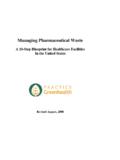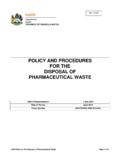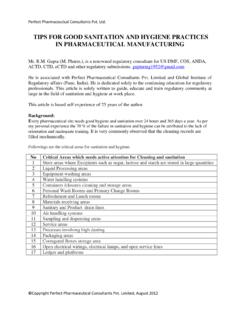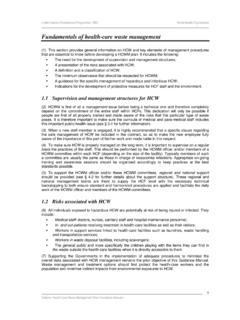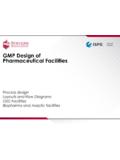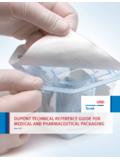Transcription of HAZARDOUS WASTE MANAGEMENT PROGRAM …
1 _____ Part 111 Administrative Rules Effective April 5, 2017 DEPARTMENT OF ENVIRONMENTAL QUALITY WASTE MANAGEMENT AND RADIOLOGICAL PROTECTION DIVISION HAZARDOUS WASTE MANAGEMENT Filed with the Secretary of State on March 29, 2017 These rules take effect 7 days after filing with the Secretary of State (By authority conferred on the director and the department of environmental quality by sections 11115a, 11115b, 11118, 11123, 11127, 11128, 11130, 11132a, 11137, 11138, 11140, 11141, and 11153 of 1994 PA 451, and Executive Reorganization Order Nos. 1995-16, 2009-31, and 2011-1, MCL , , , , , , , , , , , , , , , and ) R to R , R to R , R to R , R , R , R , R to R , R , R , R , R , R , R , R , R , R , R , R , R , R , R , R , R , and R to R of the Michigan Administrative Code are amended, R to R are added to the Code, and R of the Code is rescinded: PART 1. GENERAL PROVISIONS R Definitions; A, B. Rule 101. As used in these rules: (a) "Aboveground tank" means a device which meets the definition of "tank" in this part and which is situated in such a way that the entire surface area of the tank is completely above the plane of the adjacent surrounding surface bottom and can be visually inspected.
2 (b) "Act" means 1994 PA 451, MCL to , and known as the natural resources and environmental protection act. (c) "Act 138" means 1998 PA 138, MCL to , and known as the HAZARDOUS materials transportation act. (d) "Act 181" means 1963 PA 181, MCL to , and known as the motor carrier safety act. (e) "Act 207" means 1941 PA 207, MCL to , and known as the fire prevention code. (f) "Act 218" means sections 3101 and 3102 of 1956 PA 218, MCL and , and known as the insurance code of 1956. (g) "Act 236" means 1961 PA 236, MCL to , and known as the revised judicature act. (h) "Act 300" means 1949 PA 300, MCL to , and known as the Michigan vehicle code. (i) "Act 306" means 1969 PA 306, MCL to , and known as the administrative procedures act of 1969. (j) "Act 368" means 1978 PA 368, MCL to , and known as the public health code. (k) "Act 399" means 1976 PA 399, MCL to , and known as the safe drinking water act. (l) "Active life" means the period from the initial receipt of HAZARDOUS WASTE at a facility until the director receives certification of final closure.
3 2 _____ Part 111 Administrative Rules Effective April 5, 2017 (m) "Active portion" means that portion of a facility where treatment, storage, or disposal operations are being, or have been, conducted after November 19, 1980, and which is not a closed portion. (See also "closed portion" and "inactive portion") (n) "Active range" means a military range that is currently in service and being regularly used for range activities. (o) "Administrator" means the administrator of the EPA or the administrator's designee. (p) "Agent," when used in conjunction with the term United States importer, means an employee of the United States importer or a legally recognized representative of the United States importer who has been authorized in a lawfully executed written document, such as a power of attorney, to act on the United States importer's behalf. (q) "Agreement state" means a state that has entered into an agreement with the NRC under subsection 274b of the atomic energy act of 1954, as amended, to assume responsibility for regulating within its borders byproduct, source, or special nuclear material in quantities not sufficient to form a critical mass.
4 (r) "Ampule" means an airtight vial made of glass, plastic, metal, or any combination of these materials. (s) "Ancillary equipment" means any device, including, but not limited to, such devices as piping, fittings, flanges, valves, and pumps, that is used to distribute, meter, or control the flow of HAZARDOUS WASTE from its point of generation to storage or treatment tanks, between HAZARDOUS WASTE storage and treatment tanks to a point of disposal on site, or to a point of shipment for disposal off site. (t) "Antifreeze" means a mixture containing ethylene glycol or propylene glycol for use as a heat transfer or dehydration fluid for the purposes of regulation as a universal WASTE under R (u) "Aquifer" means a geologic formation, group of formations, or part of a formation that is capable of yielding a significant amount of groundwater to wells or springs. (v) "Associated organic chemical manufacturing facility" means a facility that meets all of the following requirements: (i) The primary SIC code at the facility is 2869 but operations may also include SIC codes 2821, 2822, and 2865.
5 (ii) The facility is physically co-located with a petroleum refinery. (iii) The petroleum refinery to which the oil that is being recycled is returned also provides hydrocarbon feedstocks to the facility. (w) "ASTM" means the ASTM International. (x) "Authorized representative" means the person who is responsible for the overall operation of a facility or an operational unit, such as the plant manager, superintendent, or person who has equivalent responsibilities. (y) "Battery" means a device which consists of 1 or more electrically connected electrochemical cells and which is designed to receive, store, and deliver electric energy. An electrochemical cell is a system that consists of an anode, a cathode, an electrolyte, and any such connections that are needed to allow the cell to deliver or receive electrical energy. The term battery also includes an intact, unbroken battery from which the electrolyte has been removed. (z) "Boiler" means an enclosed device which uses controlled flame combustion and which is either determined by the director to be a boiler based on the standards and procedures in 40 and , which are adopted by reference in R , or which is in compliance with all of the following characteristics: (i) The unit shall have physical provisions for recovering and exporting thermal energy in the form of steam, heated fluids, or heated gases.
6 (ii) The unit's combustion chamber and primary energy recovery section or sections shall be of an integral design. To be of an integral design, the combustion chamber and the primary energy recovery section or sections, such as waterwalls and superheaters, shall be physically formed into 1 manufactured or assembled unit. A unit in which the combustion chamber and the primary energy recovery section or sections are joined only by ducts or connections carrying flue gas is 3 _____ Part 111 Administrative Rules Effective April 5, 2017 not integrally designed; however, secondary energy recovery equipment, such as economizers or air preheaters, need not be physically formed into the same unit as the combustion chamber and the primary energy recovery section. The following units are not precluded from being boilers solely because they are not of an integral design: (A) Process heaters or units that transfer energy directly to a process stream.
7 (B) Fluidized bed combustion units. (iii) While in operation, the unit shall maintain a thermal energy recovery efficiency of not less than 60% calculated in terms of the recovered energy compared with the thermal value of the fuel. (iv) The unit shall export and utilize not less than 75% of the recovered energy calculated on an annual basis. In this calculation, credit shall not be given for recovered heat that is used internally in the same unit, such as for the preheating of fuel or combustion air and for the driving of induced or forced draft fans or feedwater pumps. (aa) "Burner" means an owner or operator of a facility that burns either used oil fuel or HAZARDOUS WASTE fuel. (bb) "By-product" means a material which is not one of the primary products of a production process and which is not solely or separately produced by the production process. Examples are process residues such as slags or distillation column bottoms. The term does not include a coproduct which is produced for the general public's use and which is ordinarily used in the form in which it is produced by the process.
8 R Definitions; C, D. Rule 102. As used in these rules: (a) "Carbon regeneration unit" means an enclosed thermal treatment device used to regenerate spent activated carbon. (b) "Carbon dioxide stream" means carbon dioxide that has been captured from an emission source such as a power plant, including incidential associated substances derived from the source materials and the capture process, and any substances added to the stream to enable or improve the injection process. (c) "Cathode ray tube" or "CRT" means a vacuum tube, composed primarily of glass, which is the visual or video display component of an electronic device. A used, intact CRT is a CRT whose vacuum has not been released. A used, broken CRT means glass removed from its housing or casing whose vacuum has been released. (d) "CERCLA" means the comprehensive environmental response compensation and liability act of 1980, as amended, 42 9601 et seq. (e) "Certification" means a statement of professional opinion based upon knowledge or belief.
9 (f) "Certified delivery" means certified mail with return receipt requested, or equivalent courier service or other means, that provides the sender with a receipt confirming delivery. (g) " " means the Code of Federal Regulations. (h) "Chemical agents and munitions" means chemical agents and munitions as defined in 50 section 1521(j)(1). (i) "Closed portion" means the portion of a facility that an owner or operator has closed pursuant to the approved facility closure plan and all applicable closure requirements. (See also "active portion" and "inactive portion.") (j) "Combustion zone" means the portion of the internal capacity of an incinerator where the gas temperatures of the materials being burned are within 100 degrees Celsius of the specified operating temperature. (k) "Commingling" means the transfer of HAZARDOUS wastes between containers or vehicles by a transporter during the course of transportation that results in the WASTE being mixed or repackaged. (l) "Component" means either the tank or the ancillary equipment of a tank system.
10 (m) "Confined aquifer" means an aquifer that is bounded above and below by impermeable beds or by beds that have a distinctly lower permeability than that of the aquifer itself. It is an aquifer that contains confined groundwater. 4 _____ Part 111 Administrative Rules Effective April 5, 2017 (n) "Consignee" means the ultimate treatment, storage, or disposal facility in a receiving country to which the HAZARDOUS WASTE will be sent. (o) "Consolidation" means the transfer of containers of HAZARDOUS wastes between transport vehicles by a transporter during the course of transportation without the containers holding the wastes being opened and without the wastes being repackaged. (p) "Constituent" or " HAZARDOUS WASTE constituent" means a constituent that caused the administrator to list the HAZARDOUS WASTE in 40 part 261, subpart D, a constituent that is listed in table l of 40 , or a constituent that is listed in table 201, 202, or 205 of these rules.










